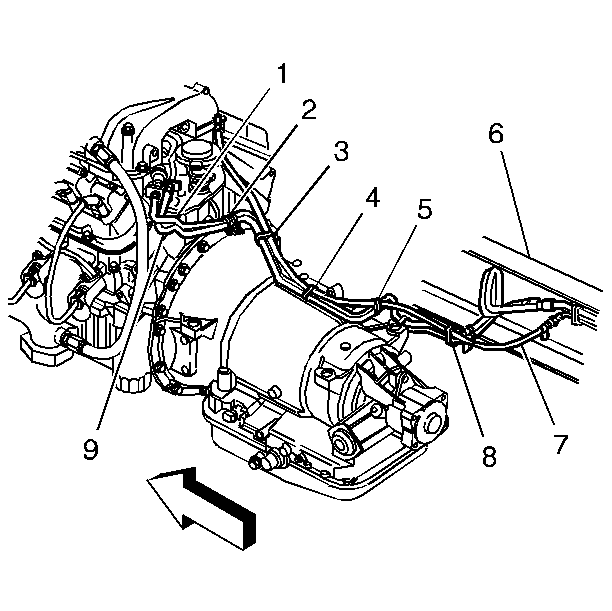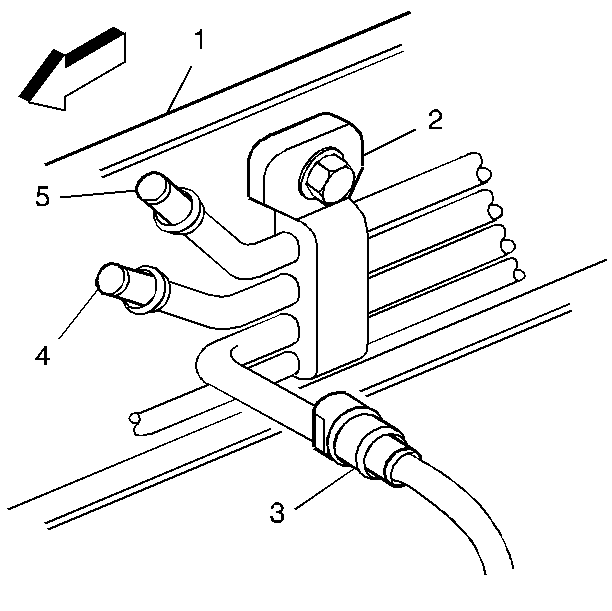Removal Procedure
Caution: Unless directed otherwise, the ignition and start switch must be in the OFF or LOCK position, and all electrical loads must be OFF before servicing any electrical component. Disconnect the negative battery cable to prevent an electrical spark should a tool or equipment come in contact with an exposed electrical terminal. Failure to follow these precautions may result in personal injury and/or damage to the vehicle or its components.
Notice: Do Not attempt to repair the EVAP pipes or the connecting hoses. Replace the damaged EVAP pipes or the connecting hoses are damaged. If the nylon EVAP pipe becomes kinked and cannot be straightened, it must be replaced.
Notice: Replace the EVAP pipes and hoses with the original equipment or parts that meet the GM specifications for those parts. The replacement EVAP pipe must have the same type of fittings as the original pipe in order to ensure the integrity of the connection. When replacing EVAP hoses, use only reinforced fuel-resistant hose identified with the word Fluoroelastomer or GM 6163-M on the hose. The inside hose diameter must match the outside pipe diameter. Do not use rubber hose within 100 mm (4 in) of any part of the exhaust system or within 254 mm (10 in) of the catalytic converter.
- Disconnect the negative battery cable.
- Relieve the fuel system pressure. Refer to Fuel Pressure Relief in Engine Controls.
- Drain the fuel tank. Refer to Fuel Tank Draining in Engine Controls.
- Clean all the fuel and EVAP pipe connections and the surrounding areas before disconnecting the pipes in order to avoid possible contamination of the fuel system.
- Disconnect the fuel feed pipe (9) and fuel return pipe (1) from the engine.
- Drain any remaining fuel from the fuel pipes into an approved gasoline container.
- Remove the pipe clamp fastener (2) from the rear of the transmission bell housing to the engine.
- Remove the pipe strap fastener (3) from the fuel pipes and EVAP pipe.
- Remove the EVAP pipe fastener from the rear of the upper intake manifold.
- Remove the EVAP pipe from the EVAP purge solenoid valve.
- Raise the vehicle. Refer to Lifting and Jacking the Vehicle in General Information.
- Disconnect the fuel feed pipe (5) and fuel return pipe (4) from the chassis (1). Refer to Metal Collar Quick Connect Fitting Service in Engine Controls.
- Disconnect EVAP pipe (3) from the chassis (1). Refer to Plastic Collar Quick Connect Fitting Service in Engine Controls.
- Carefully remove the fuel feed pipe (9), fuel return pipe (1) and EVAP pipe (7) from the vehicle.
- Observe the following when replacing EVAP pipes/hoses:
- A minimum of 13 mm (0.5 in) clearance must be maintained around sharp edges such as flanges, pinch welds, etc., in order to prevent contact and chafing. A minimum of 19 mm (0.75 in) clearance must be maintained around all moving parts.
- Cut the ends of the pipe remaining on the car square with a tube cutter. Using the first step of a double flaring tool, form a bead on the end of both pipe sections. If the pipe is too corroded to withstand the beading operation without damage, the pipe should be replaced. If a new section of pipe is used, form a bead on both ends of the pipe also.
- Use screw type hose clamps. Slide the clamps onto the pipe and push the hose 51 mm (2 in) onto each portion of the fuel pipe.
- Follow the same routing as the original pipe.

Important: Note the position of the fuel pipes and attaching hardware for installation. Inspect the pipes for bends, kinks, and cracks. Repair or replace the pipes as required.
Caution: Refer to Vehicle Lifting Caution in the Preface section.

Important: When repairing the fuel or EVAP pipes with hoses, always replace them with original equipment or parts meeting GM specifications. Use only reinforced fuel resistant hose which is identified with the word Fluoroelastomer or GM 6163-M on the hose. The inside hose diameter must match the outside pipe diameter.
Important: Do Not use rubber hose within 100 mm (4 in) of any part of the exhaust system or within 254 mm (10 in) of the catalytic converter.
If more than a 6 in length of pipe is removed, use a combination of steel pipe and hose so that the total hose lengths, including the 100 mm (4 in) additional length will not be more than 254 mm (10 in) long.
Installation Procedure
- Position the fuel and EVAP pipes from the frame rail (6) to the engine.
- Loosely install the pipe clamp fastener (2) to the rear of the transmission bell housing to the engine.
- Loosly install the fuel feed pipe (9) and fuel return pipe (1) to the engine.
- Align the fuel and EVAP pipes to (8,5,4,3) position.
- Install the pipe strap fasteners.
- Tighten the fuel feed pipe (9) and fuel return pipe (1) to the engine.
- Tighten the pipe clamp fastener (2) to the rear of the transmission bell housing to the engine.
- Install EVAP pipe (3) to the chassis (1). Refer to Plastic Collar Quick Connect Fitting Service in Engine Controls.
- Install and tighten the EVAP pipe fastener to the rear of the upper intake manifold.
- Install the EVAP pipe to the EVAP purge solenoid valve.
- Install the fuel feed pipe (5) and fuel return pipe (4) to the chassis (1). Refer to Metal Collar Quick Connect Fitting Service in Engine Controls.
- Lower the vehicle.
- Refill the fuel tank.
- Tighten the fuel filler cap.
- Connect the negative battery cable.
- Inspect for leaks.

Notice: Properly secure the EVAP pipe in order to prevent chafing of the pipe.
Important:
• When replacing the fuel or EVAP pipes, always replace them with
original equipment or parts that meet the GM specifications for those parts.
The replacement pipes must have the same type of fittings as the
original pipes in order to ensure the integrity of the connection. • Do Not use copper or aluminum tubing to replace steel tubing.
Only tubing meeting the 124-M specification or its equivalent is capable
of meeting all pressure, corrosion and vibration characteristics
necessary to ensure the durability standard required.
Notice: Use the correct fastener in the correct location. Replacement fasteners must be the correct part number for that application. Fasteners requiring replacement or fasteners requiring the use of thread locking compound or sealant are identified in the service procedure. Do not use paints, lubricants, or corrosion inhibitors on fasteners or fastener joint surfaces unless specified. These coatings affect fastener torque and joint clamping force and may damage the fastener. Use the correct tightening sequence and specifications when installing fasteners in order to avoid damage to parts and systems.
Tighten
Tighten the pipe clamp fastener to 26 N·m (19 lb
in).

| 16.1. | Turn the ignition switch ON for 2 seconds. |
| 16.2. | Turn the ignition switch OFF for 10 seconds. |
| 16.3. | Turn the ignition switch ON. |
| 16.4. | Inspect for fuel leaks. |
